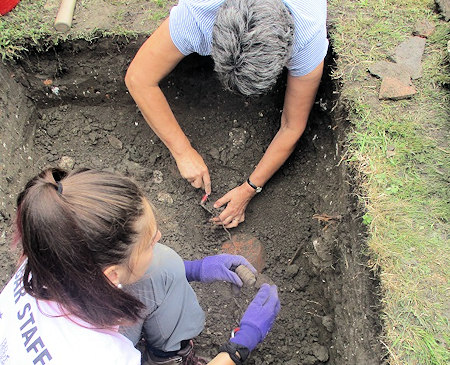Archaeology on Romney Marsh
This page provides information about Archaeology on Romney Marsh.
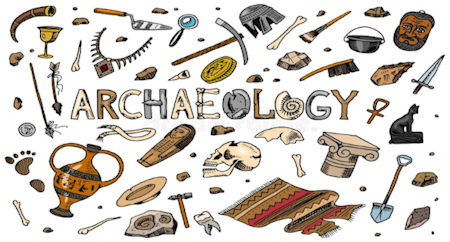

Archaeology is the study of the human past. It addresses big questions about our past that cannot be answered in other ways. Archaeologists are interested in all aspects of the people of the past, from their diets to their beliefs, the clothes and jewellery they wore, the tools and cooking pots they used, the houses they lived in and the ways they commemorated their dead.
Romney Marsh is a remarkably young part of the English coast. At the end of the last ice age, sea levels were over 100 metres lower than present and one could walk from Rye across the exposed floor of the English Channel to France. As the climate warmed and sea levels rose, so the Channel was flooded and the sediments that make up the marshland accumulated. To look into any of the many hundreds of drainage ditches criss-crossing the marsh is to catch a glimpse of an early history dominated by changes in sea level. To look up is to see a landscape that, over the last 4,000 years, has been moulded by many phases of human settlement and activity. This varied history is recorded in the sediments and landforms of the marsh, in its archaeology, and in a wealth of documentary evidence providing fascinating insights into the lives of people working and living on the Marsh since the Roman period. text courtesy of the Romney Marsh Research Trust
Romney Marsh Community Archaeology Group
The Romney Marsh Community Archaeology Group (ROMCAG) was formed in 2022 by a group of volunteers, keen on uncovering the history and archaeology of Romney Marsh. Many of them had previously volunteered with archaeology at different stages of the Fifth Continent Project and when the Fifth Continent Project came to an end, their vision was to create an enduring archaeological legacy for the Marsh community.
The aim 0f ROMCAG is to discover the area’s heritage using research - oral history, archived documents, reports, newspapers and books as well as archaeological methods — geophysics, excavation, finds processing and conservation - sharing this knowledge with the local community, to preserve and celebrate the rich history of the Marsh for future generations.

Unearthing the hidden heritage of the Fifth Continent
If you are interested in getting involved, please contact the group by ![]() email. No history or archaeology experience needed, just enthusiasm!
email. No history or archaeology experience needed, just enthusiasm!
The Romney Marsh Research Trust was formed in 1987 to study the history, archaeology and landscape history (or ‘geomorphology’) 
of Romney Marsh following the establishment of the Romney Marsh Research Group in 1985. Romney Marsh, one of the largest areas of coastal marshland in the UK, has a fascinating many-sided history starting at the end of the last ice age. Membership of the Friends
of the Trust was dominated by members of the public and included local historians and archaeologists, as well as a diverse group of specialists from universities throughout the UK. The principal aim was to make the work of the Trust as widely available as possible. From its inception, we hosted events to publicise our research, to which all members were invited, including field demonstrations, lectures and walks. Research has also been also published in journals and the Trust’s own publications.
Monographs
Between 1988 and 2011, The Romney Marsh Research Trust published five monographs which in total have over 60 separate papers on the Marsh by a wide range of authors. You can find an index to these papers on their website. It can be searched by keyword or sorted by clicking on any of the titles. Clicking on the title will bring up a readable file of the relevant paper.
You can find out more about the Romney Marsh Research Trust on their website.

This project by the Fifth Continent Landscape Partnership Scheme will help to discover the most likely location of the original Romney Port which would have been significantly inland from where the coastline is today. (see our History pages)
The project will be delivered through volunteers and the Heritage Officer. Some research will need to be done on where the most likely places are, and then field surveys will be undertaken, with two test pitting weekends, focussing on ground-truthing and LiDAR data, and finds will be catalogued and sent to professionals for analysis.
The project is ongoing and you can find out more about the project and keep up to date with its progress at
https://fifthcontinent.org.uk/projects/project-themes/rediscover/hunt-for-romney-port/
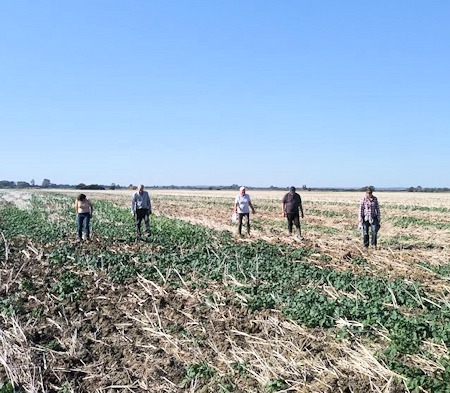
Hunt for Romney Port

Archaeology Dig for History in Brenzett August 2019
Fifth Continent’s dig for History in Brenzett… by Andrew South
The Old Rectory in Brenzett was the site of a community effort last summer to uncover the remains of an original medieval vicarage building. The four-day archaeological dig brought together people of all ages and experience in a fascinating mission of discovery back in time.
Initially suggested by Robyn Collins of the Brenzett History Group, the dig was the last in the summer season organised by the Fifth Continent team’s Heritage Officer, Lucie Bolton.
“We started with geophysical images from above which showed that there had definitely been some sort of construction next to the current building at some point,” Lucie told me on the morning of the third day of the dig, where the Old Rectory garden was pockmarked with piles of spoil and pits, meticulously being worked on by small teams of enthusiastic diggers and scrapers.
“Having discovered that there had been something on the site, we undertook further research in the archives in Maidstone which revealed that the building dated from 1313, so when arrived here we were able to stake out roughly where we thought the walls may have been.”
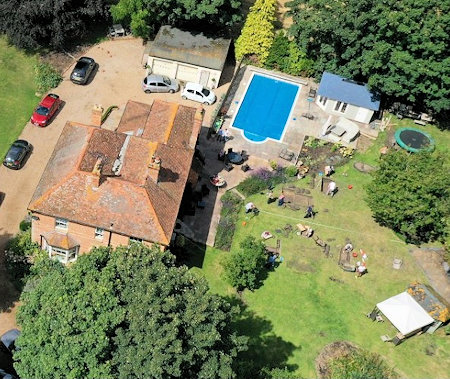
This is where the real detective work starts, with each plunge of the spade or trowel potentially revealing something new. The rectangular trenches are excavated in layers, and systematically arranged along the suspected line of the walls, to minimise disruption and possible damage to the Rectory’s beautiful garden!
Only a few inches down, the diggers had found a line of what appeared to be a ramshackle wall consisting of bits of flint, stones and even some random bones. It was odd to think that 800 years ago, people had expended time, effort and care in building such a rudimentary structure by today’s standards, and aiming to satisfy their everyday needs for food, water and shelter.
“My view is that this was probably a wooden building and that this was a base wall, which would explain why the timber frame has long since decomposed,” explained Lucie.
However, the most productive trench was one which was thought to be an original rubbish tip – a sort of proto-type mini landfill site – which turned up a pot-pourri of broken earthenware, pots, dishes and a cache of animal bones, mostly sheep and cattle it seems. There were also plenty of oyster shells which would have been offered to farm-workers due to the mollusc’s riverine and coastal abundance in the area at that time.
There were also many medieval bricks, identifiable from their much smaller and thinner form and without the ‘frog’ – the central hollow or groove we recognise in modern bricks.
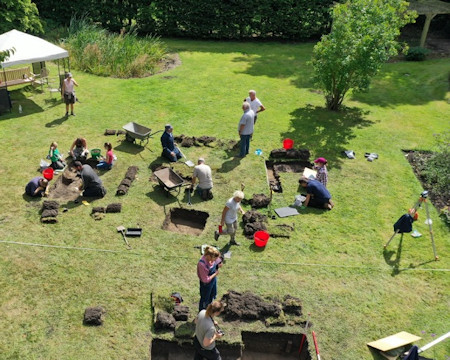
But there is much more to the art of archaeological than digging up the detritus of generations past – it became apparent that this was much more about the piecing together of an intricate chronological jigsaw, with a timeline that began 1.2 metres deep.
Every item has to be cleaned of extraneous centuries of accumulated dirt, mostly with the use of differing heads of toothbrushes, which seemed wholly appropriate when it came to cleaning out the toothy ruminant jawbones from centuries past.
The exact location of each discovery is recorded, and the piece then bagged for later investigation and classification. One item being cleaned by Lucie’s grandfather Derek, was an old thrupenny bit – the original forerunner of ‘Bitcoin’ perhaps?
For 11-year-old Nathaniel from Lydd, this was a dream come true. “He is absolutely nuts about history – especially where smugglers and pirates are concerned,” his mum tells me, while her son was completely absorbed with the task in hand. “He wanted to find a young archaeological group, but we saw this event advertised and thought it would be an ideal first experience of being involved in a dig.”

This seemed a perfect way to while away a few hours for anyone of any age, experience or level of knowledge – you certainly don’t need to be an expert to scrape your way through layers of compacted soil, with the prospect of the next inch of dirt revealing a precious artefact, now free to tell its historic story to its finders.
Eve from New Romney had come across the Fifth Continent’s archaeological work when they had worked on plots in St. Martin’s Field in the town earlier in the summer.
“I have a degree in archaeology, but somehow my life took a different path,” she told me. “But I re-discovered my interest when I joined the work in St. Martin’s Field in New Romney, and have also done some graveyard surveys on the Marsh.
“I have had to re-learn techniques, but some of the volunteers here are so experienced and really helpful. The history of the Marsh is complicated – smugglers, churches, communities – so it is important to record and remember the past before it disappears.”
Also on site was Tom Ward who won the Fifth Continent’s 72-hour film challenge earlier this summer, and was filming the excavation over the four days for a forthcoming short video.
“Winning that competition has certainly opened up new opportunities for me, and will look good on my CV,” he told me. “One idea I am working on is an animated film of what the Marsh may have looked like centuries ago.”
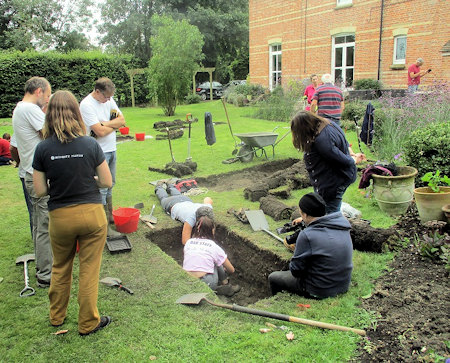
But what of the owner, whose garden was being turned into something of an organised holey mess, which to some may seem fitting given that Russell Bates is a Minister who is all yours to officiate at funerals, weddings and Christenings to order.
“We moved here eight years ago,” he told me as we watched the digging continue over a welcome cup of tea. “Although the first date we know of a vicarage here is 1313, there are still gaps in the story which involves Henry VIII and Catherine Parr. There is quite a bit of information at Canterbury Cathedral and the well-known Marsh name of ‘Brockman’ appears almost continually, on the basis that if it was your name, you would become the Vicar and if not, the Vicar would be given the name of ‘Brockman’!”
It seems that the grinding of wheels within wheels has been a recurringly resonant sound on the Marsh for centuries…
And on the fourth day, the dig did finish. Hundreds of pieces of artefacts will be taken away for further analysis as part of the Fifth Continent’s heritage remit to work with landowners to help them value the archaeological features on their land.
The work is ongoing.
